Mar 28, 2011 | sculpture, The Louvre

Jean Baptiste Pigalle
L’amour embrassant L’Amitié
(according to GoogleTranslate: “Love kissing Friendship”)
Covered in a layer of age, a young mother embraces her angel child with a soft, careful expression on her face. Her loose dress spills around her and her delicate life-like hands hold the winged baby who stands to her left- up on a log so he can get even closer to her. She’s sitting on the remains of a tree and a wreath of flowers, logs, and rocks rest at their feet. The baby wears nothing but his wings, his right arm wrapped around his mother’s shoulder, looking up at her with a face filled with love as she stares back at him– the pair forever locked in a staring contest that reveals every dynamic of their relationship instantly.
Mar 24, 2011 | theater
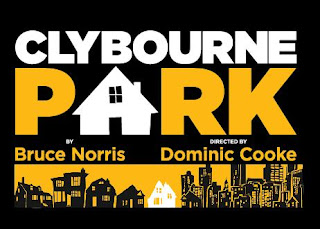 “How many white men does it take to change a light bulb?”
“How many white men does it take to change a light bulb?”
The second act of Bruce Norris’ new play Clybourne Park is sprinkled with this kind of would-be offensive humor, showing how the innate racism within everyone can be covered up in the context of a joke. Which is really how the entire play functions, with Bruce Norris’ insanely clever writing and the actor’s hilarious delivery of lines making the audience laugh their way through this intense social commentary.
The play is performed in two acts, one in 1959 and the second in 2009, and each one juxtaposes the other perfectly, proving that it’s going to take a lot longer than fifty years for racism to disappear because the same issues and dialogue are still around. In the first act it’s pointed out that the black couple can’t ski, and in the second, the wife laughs at the idea of her white husband trying. And both revolve around the attempt to stop the other race from infiltrating ‘their’ neighborhood, in 1959 it was the blacks and in 2009 the whites, both acts echoing the same quote, “You can’t live in a principle.” Norris’ writing is what made the play so powerful, but it was the acting that made it a riot.
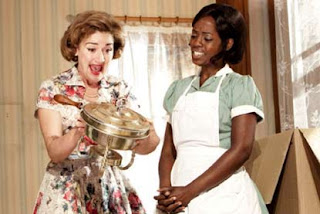 The entire first act was performed under a shade of irony, with every character exuding a ‘Hi neighbor!’ characteristic indicative of what everyone thinks the fifty’s were like—according to I Love Lucy at least. Sophie Thompson as the wife Bev took the first act by storm, with her hilariously forceful voice and adorable naivety making her the most entertaining on the stage. But Sam Spruell who played the ever-so-helpful pastor Jim never once let his ridiculous smile fall, irony dripping from his mouth every time he spoke. But only Stuart McQuarrie as Bev’s husband Russ seemed like he could have actually existed, the sadness over the loss of his son pushing him away from the happy-go-lucky attitude of his wife and neighbors.
The entire first act was performed under a shade of irony, with every character exuding a ‘Hi neighbor!’ characteristic indicative of what everyone thinks the fifty’s were like—according to I Love Lucy at least. Sophie Thompson as the wife Bev took the first act by storm, with her hilariously forceful voice and adorable naivety making her the most entertaining on the stage. But Sam Spruell who played the ever-so-helpful pastor Jim never once let his ridiculous smile fall, irony dripping from his mouth every time he spoke. But only Stuart McQuarrie as Bev’s husband Russ seemed like he could have actually existed, the sadness over the loss of his son pushing him away from the happy-go-lucky attitude of his wife and neighbors.
With the changing of the acts came the complete reversal of the set, the once beautiful home now dilapidated and crumbling. And conducive to Norris’ echoing theme, the same actors played their 50-years-later counterparts, giving those with the quieter parts in the first act a chance to yell and scream and get offended. Which is exactly what happened as the tiptoe dance of political correctness pushed everyone to the edge. Sarah Goldberg as the pregnant wife Lindsey dominated the second act with her exclamations of “Half of my friends are black!” and “Well that was insulting,” her character serving as I’m-not-racist angel on everyone’s shoulder that whispers, ‘You better not tell that joke.’ But no matter how hard Lindsey tries to excuse her husband’s behavior, it is his bluntness that reveals the brilliantly made point of Clybourne Park: that the current obsession with political correctness doesn’t really make anybody colorblind.
Oh, and it takes one white man to hold the light bulb while the rest of them screw the entire world. Please don’t be offended.
Feb 6, 2011 | illustration, The British Museum
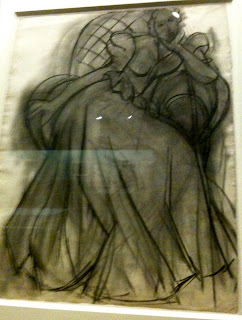
Henri Matisse, Woman seated in an armchair wearing a taffetta dress, 1938. Charcoal.
Her long, swooping dress takes up the entire bottom half of the picture. And as she sits leaning to one side, a ruffle cuts across her waist and her dress swings to the right as if the wind were blowing it that way. Lighter charcoal strokes outline where her leg rests underneath the fabric. She sits propping up her face with her left hand as that elbow rests on the chair, making her face tilt. Her features are pleasant and simple, she’s in no rush for whoever she’s waiting for. She looks like she’d be sighing instead of talking. Not a dramatic, exhausted sigh, just the pleasant high pitched one girls make when they see something pretty. Her right arm matches the contour of her dress and the imperfect hand holds the arm of the chair. Her sleeves are big and pouffy but the neckline of the dress is a simple V, with her right breast heavily outlined while her left rests on the large arm of the chair. Her hair starts where her ears would be if she had any, and it looks like a cloud a kindergardener would draw on a landscape- just a continuous squiggle cut off by her face and continuing on the other side. The crisscross pattern of the arm chair can be seen behind her, but only on her right side because she’s leaning, waiting patiently.
Feb 6, 2011 | theater
 On my second venture to the National Theatre in London, I saw Greenland, a show about how we are responsible for climate change and the inevitable destruction of the earth. Well, it was pretty in your face to say the least. Which would have been fine, I get it, you have a message you need to get across, yadda yadda yadda, but the acting was pretty bad and the plot as a whole didn’t have much of a point.
On my second venture to the National Theatre in London, I saw Greenland, a show about how we are responsible for climate change and the inevitable destruction of the earth. Well, it was pretty in your face to say the least. Which would have been fine, I get it, you have a message you need to get across, yadda yadda yadda, but the acting was pretty bad and the plot as a whole didn’t have much of a point.
There were three main plot lines in total that alternated time on the stage. One of a naive teenage girl determined to save the planet, the second of a scientist who predicted that New York City will be under sea level by 2030 (and let me tell you, if that happens, I’m going down with it) who still wants to have kids anyways and spends most of the show trying to get the girl he likes to have his babies, and the third story follows a bird watcher in the arctic whose relationship with the teenage boy who accompanies him is never really explained. Kinda weird. But none of these plots really resolved themselves or went anywhere, and there were repetitive interrupting bits about basically nothing that were very distracting and made very little sense. One of these bits involved the Copenhagen Climate Conference in 2009 and the play very obviously blamed Obama for why it didn’t work. And there were other little jabs at America too which I wasn’t particularly fond of. (DON’T TREAD ON US.)
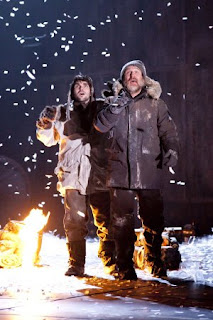
But perhaps the worst thing about this play was the general hypocrisy of it. The actors were basically screaming at us not to buy food from grocery stores because they come in plastic containers that fill up a waste island in the Pacific that is apparently as big as France, and crying that recycling isn’t good enough. But the entire time paper was falling from the ceiling and at the end of the play, a huge fan was turned on and the paper was literally blown into our faces. And even though they might reuse that paper play after play, when the show ends, what are they going to do with it? RECYCLE. Plus, the entire backdrop of the stage was a giant screen, and the power it required for one performance could have probably powered most of Manhattan for an hour. Not to mention the extreme number of props, most of which were unnecessary, and the money to buy them could have actually gone towards something that would actually help. But WHATEVER. The whole thing made me want to not recycle on purpose just to get back at them for wasting two hours of my life. But I suppose that’s how it is with most things that are shoved down our throats. Not only do we not want to eat it, we also want to throw up all over the ones doing the shoving.
Feb 2, 2011 | sculpture, The British Museum
Ming Dynasty, 16th century AD. British Museum.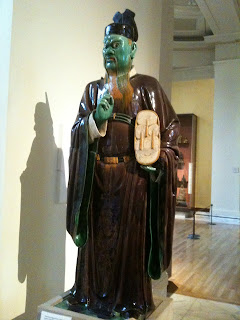
He obviously takes himself a bit too seriously. Standingabout four feet high and made of colored and polished stone is the figure of an Asian higher-up from the 16th century, most likely a religious figure. With greenish turquoise skin and a combed through beard that melts into his chest, his expression says something like, “Really? You’re going to wear that?”– both critical and repulsed. In his left arm he hugs a bundle of scrolls close to his body and his right hand is positioned in front of him delicately. His middle finger is missing, not that he would ever need it. His floor length deep purple robe is belted with the same color as both his beard and the wrap bundled over his scrolls– a light muddy color that might be found on the side of the road after it rains. A white color protrudes around his neck and the same color white sleeve comes out with his right hand from his long draping robe. The sleeves of his robe hang past where his knees would be, almost to the ground. And his widened, critical eyes are black and stare straight at you if you stand in the just the right place, nostrils flared. Tassels hang from the top three scrolls in the bundle and his left foot peaks out beneath his robe. But his cap is most important, a darker purple than his robe, and with a mini headboard at the back of it. Like one you might find in a tacky hotel suite with a queen-sized bed.









